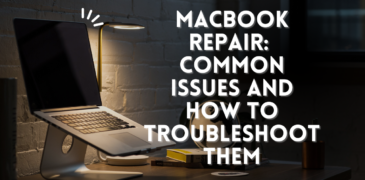As a MacBook user, it’s likely that you heavily depend on your device for work, entertainment, and communication. Despite the reputation for reliability and durability that Macs have, they can still suffer from occasional malfunctions or glitches that can disrupt your workflow or leisure time. Problems such as a frozen screen, dead battery, or malfunctioning keyboard are just a few of the issues that MacBook users may face during the lifetime of their device.
Luckily, there are ways to diagnose and repair many of the typical MacBook problems without the need for expensive repairs or a trip to the Apple Store. By utilizing some straightforward troubleshooting methods and practical tools, you can frequently fix your MacBook on your own, ultimately saving you valuable time, money, and frustration.
Let’s delve into some of the typical issues that MacBook users encounter, and discover how to troubleshoot them through step-by-step instructions in this article. Whether you’re a long-time MacBook user or a recent convert, this guide will assist you in keeping your device functioning seamlessly and dependably. This way, you can concentrate on your work and leisure activities without worrying about technical difficulties. Are you ready to start troubleshooting? Let’s dive in!
Battery Problems
Battery issues are a prevalent problem that MacBook users face, and some indications of a faulty battery are:
- Improper charging of the battery
- The MacBook not powering on
- Rapid battery drainage
You can attempt the following steps to troubleshoot battery problems:
- Verify the battery health status in System Information to determine if it needs replacement.
- Recalibrate the battery by resetting the SMC (System Management Controller).
- Minimize battery consumption by shutting down unnecessary apps and disabling Bluetooth and Wi-Fi.
If these steps don’t resolve the issue, you may need to replace the battery.
Overheating
Another common MacBook issue is overheating. This can be caused by a number of factors, including:
- Blocked ventilation
- Running too many apps at once
- Malfunctioning fan
To troubleshoot overheating, you can try the following steps:
- Clear any blockages around the MacBook’s vents.
- Use Activity Monitor to identify which apps are using the most CPU and memory, and close them if necessary.
- Check the fan to see if it’s working properly.
If none of these steps resolve the issue, you may need to take your MacBook to a professional for repair.
Software Problems
Sometimes, MacBook issues can be caused by software problems. Some common software issues include:
- Frozen apps
- Slow performance
- Kernel panics
To troubleshoot software problems, you can try the following steps:
- Force quit any frozen apps.
- Clear out unnecessary files and applications to free up disk space.
- Use Disk Utility to repair any disk errors.
If these steps don’t work, you may need to reinstall macOS or seek professional help.
Hardware Malfunctions
Finally, some MacBook issues may be caused by hardware malfunctions. Some signs of hardware problems include:
- Strange noises coming from the MacBook
- Cracks or dents in the casing
- Non-functional ports
To troubleshoot hardware malfunctions, you can try the following steps:
- Run Apple Diagnostics or Apple Hardware Test to identify the problem.
- Check if the MacBook is still under warranty and contact Apple support for repair options.
- Take the MacBook to a professional repair service.
Also read:
4 of the Most Common Mac Issues & their Quick Fixes
Top 10 Best 3rd Generation Core i7 Laptops
How to change location on your iPhone and iOS with simplest steps
FAQs
What are some of the problems commonly experienced by MacBook users?
MacBook users may encounter issues such as battery problems, software crashes, slow performance, Wi-Fi connectivity problems, and hardware malfunctions.
How can I troubleshoot battery issues on my MacBook?
To troubleshoot battery issues on your MacBook, start by checking the battery health status in the system information. If the battery health is poor, consider replacing the battery. Additionally, adjust the display brightness and turn off any unnecessary applications to conserve battery life.
What should I do if my MacBook is running slow?
If you’re experiencing slow performance on your MacBook, you can take some steps to troubleshoot the issue. Begin by clearing the cache and deleting temporary files. Optimizing your hard drive by removing unnecessary files and applications can also help. If the issue persists, consider upgrading your RAM or replacing your hard drive with an SSD. These upgrades can significantly improve your MacBook’s performance.
How can I fix Wi-Fi connectivity issues on my MacBook?
If you’re experiencing Wi-Fi connectivity problems on your MacBook, begin by verifying your network settings and confirming that your Wi-Fi network is configured correctly. If this isn’t effective, attempt resetting the Wi-Fi module or the SMC. Additionally, connecting to a different Wi-Fi network may help pinpoint the problem.
What should I do if my MacBook freezes or crashes frequently?
If your MacBook freezes or crashes frequently, start by checking for any software updates and installing them if necessary. You can also try resetting the NVRAM or reinstalling the operating system. If the issue persists, it may be due to a hardware problem and you should contact a professional for repair.
Can I fix hardware issues on my MacBook on my own?
While some hardware issues on a MacBook can be fixed on your own, such as replacing a battery or upgrading the RAM, other repairs may require professional assistance. It’s important to avoid attempting repairs that you’re not comfortable with or that could cause further damage to your device.
Conclusion
To sum up, although dealing with MacBook problems can be aggravating, most of them can be resolved with some troubleshooting. By recognizing the typical issues and implementing the suggestions outlined in this guide, you can prevent wasting time and money on unnecessary visits to the repair shop.
Regularly updating the software, being mindful of accumulating unnecessary files and programs, and handling your MacBook with care are essential preventive measures that can ensure its longevity.
Should you encounter a problem that you cannot resolve independently, it is recommended to promptly contact an Apple-certified technician. Their specialized expertise allows them to pinpoint the issue and provide the appropriate solutions to restore your MacBook’s functionality.
By conscientiously adhering to these tips and tricks, you can maintain your MacBook in excellent condition, guaranteeing a smooth user experience. Hence, if you encounter an issue in the future, remain calm and swiftly consult the steps mentioned in this guide without any reluctance.







